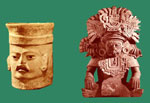|
MAJOR ARCHAEOLOGICAL SITES: PreClassic to PostClassic
MONTE ALBÁN (circa 500 B.C.- A.D. 800)
Monte Albán is located at the summit of a 1300 foot high mountain that was leveled over hundreds of years for the construction of a ceremonial and civic center that ultimately covered some 25 square miles. It was occupied between 500 B.C. and A.D. 800 making it one of the longest, continuously occupied communities in Mesoamerica. By A.D. 400, what had been rival villages for centuries during the Preclassic had now become regional administrative centers ruled by lesser ranking families who were incorporated into a system of power sharing through exclusive intermarriages, gifts, and rewards. Monte Albán's kings were thereby able to transform distant regions into rich tribute paying provinces ultimately controlling much of the state of Oaxaca and beyond. Carved jades and fragments of polychrome ceramics bear testimony to long distance trade with the Classic Maya of Chiapas and Guatemala. Over 250 miles to the north in the Valley of México, a Monte Albán barrio was established at the metropolis of Teotihuacán.
 |
Looking down the axis of the main plaza one is struck by how the site plan mirrors the layout of the Valley of Oaxaca itself. This was probably intentional. Most of what has been excavated dates to the Classic period between A.D. 450-800. However, an early Preclassic building was found beneath Temple L at center of photo and is dated to 500 B.C. It is here that many of the monuments erroneously called “danzantes” (dancers) were found. Actually, these figures depict the defeated chiefs of surrounding communties. Click on Image for more detail. |
 |
Building J located at the southern end of the main plaza is an anomaly. Its floor plan resembles a spear head. Dating to the Late Preclassic, the walls were fitted with carved stone panels depicting place sign for kingdoms defeated by Monte Albán. Click on Image for more detail. |
 |
A reconstruction of Temple M featuring a typical Temple-Patio-Adoratory complex. By the Classic period, Zapotec architects were designing high-stepped temple platforms faced with scapular panels abstracted from the image of a parrot’s head, divided. Click on Image for more detail. |
 |
The northern perimeter of the great plaza is defined by the North Platform. It is thought to have been the principal residence of Monte Albán's highest ranking royal family. Fortified by high foundation walls on all four sides, the only entrance was by way of the steep staircase and the colonnaded alcove at its summit. The interior featured temples and residence platforms constructed around a sunken patio. To the northeast are three small structures. The largest, Temple G, dates to Monte Albán II and contained the remains of women who were interred with rich offerings of greenstone, shell, and pearls. Click on Image for more detail. |
 |
The Zapotecs believed that the souls of the royal ancestors passed on to a kind of paradise where they lived very much as they had in life, except that they were to act as intercessors between gods and men. They were called upon to promote agricultural fertility or to cure diseases that were thought to be caused by transgressions against spirit forces in nature. Consequently their descendants were very careful to honor their memory not only by regularly dedicating rituals to their physical remains, but also by sculpting their likenesses on clay urns that were placed among the tomb furniture. The earliest urns date to the PreClassic. They are remarkable in capturing human personality, handsome young men and women, and snarling war chiefs, but through time emphasis was increasingly placed on the symbolism of institutional power displayed in ritual dress. By Monte Albán III, faces became stark, expressionless, and overshadowed by towering headdresses of feathers and monstrous masks. Click on Image for more detail. |
Previous Page | Sites Index | Next Page
Table of Contents
Return to top of page |






